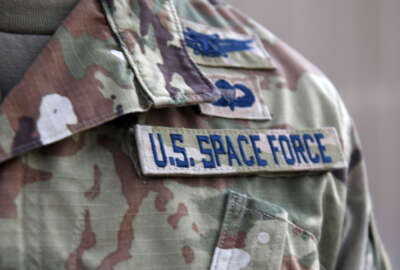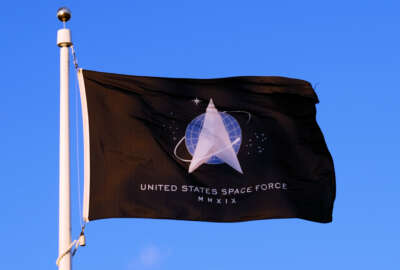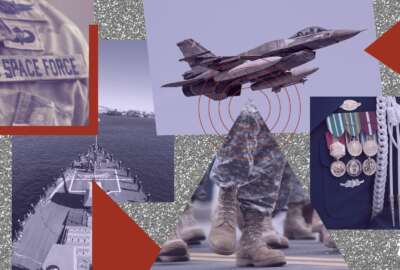NASA’s worries are not just about space, but about space sustainability
NASA has a Space Environment Sustainability Advisory Board to help guide policy for an area of space that is starting to look like the Beltway at rush hour.
The more nations launch satellites into space, the more crowded the orbit layers become, especially in the burgeoning low-earth orbit. NASA has a Space Environment Sustainability Advisory Board to help guide policy for an area of space that is starting to look like the Beltway at rush hour. The board has defined the problem in terms of five challenges. For more, The Federal Drive with Tom Temin talked with the associate administrator for NASA’s office of Technology, Policy and Strategy, Charity Weeden.
Interview Transcript:
Tom Temin The more nations launch satellites into space, the more crowded the orbit layers become, especially in the burgeoning low earth orbit. NASA has a space environment sustainability advisory board to help guide policy for an area of space that’s starting to look like the Beltway at rush hour. The board has defined the problem in terms of five challenges, and here with more, the associate administrator for NASA’s Office of Technology, Policy, and Strategy, Charity Weeden joins me in studio. Ms. Weeden, good to have you with us.
Charity Weeden Hi. How are you doing?
Tom Temin All right. Good to have you in here. And let’s begin with a definition here. What is sustainability in space to begin with?
Charity Weeden That’s a really important question to ask, so we’re all on the same page. In layman’s terms, it means what we do today, make sure it doesn’t negatively impact what we do tomorrow and those opportunities. When it comes to space, make sure our activities are responsible in orbit so that we can continue to use space for all the benefits we get from it, and future generations can use it as well.
Tom Temin And let me just ask a technical question before we get into the broader policy issue. Lots of companies are launching space items, small satellites, maybe, in fleets of them, sometimes clouds of them for various purposes of earth observation or communications. When they do that, what is required of them? Can they just say, “Tuesday, I’m going to launch”? And then, Tuesday afternoon, the belly of the mothership is going to open and these things are going to get ejected? Is there any rules of the road now, for, well, “you can do it at 3 a.m., but you can’t do it at 3:15 because you’ll be too close to the last week’s satellites”?
Charity Weeden Well, private operators do need a license from the government. And this comes back to an international treaty called the Outer Space Treaty, where every nation is responsible and liable for private and citizens and their actions in orbit. So in the United States, that means your activity in space needs to be licensed. And there’s several license authorities in the United States. NASA is not one of them, but there’s the FCC, there’s NOAA, there’s FAA, to name a few of some satellite companies would have to go through those license authorities first.
Tom Temin But is there a protocol for making sure that when they are released into the low earth orbit, that they are done in a way that they won’t crash into something that might be orbiting by two minutes later?
Charity Weeden Right. So, in that license process, there are questions asked about their debris mitigation plans. The FAA has some of that. FCC certainly has the requirement to show your debris mitigation plans. So, that’s part of the license process. But it’s not 100% clear the entire world is using the same rules, and that’s where we are right now. Space is congested. We’re not quite sure where everything in orbit is, especially the small stuff. And we’re not quite sure what other actors are doing in orbit. And that can create havoc when you’re trying to get good science done, inspire new generations to look towards the space environment. And so it’s important to have common rules, like you said, to have that authority and supervision and make sure we keep the space environment clean.
Tom Temin And two other questions then, do we have a sense of the order of magnitude of quantity of satellites in low earth orbit at this point?
Charity Weeden Well, we certainly have a good understanding of the number of satellites in orbit. It’s on the order of 5,000 or so right now. The problem is, we don’t necessarily know exactly where all the small pieces of debris are. And we modeled upwards of 500,000 or more pieces of small debris that we can’t even track. And that could be really devastating for a mission. So that’s the essence of the issue; if you can’t maneuver out of the way of debris, then we have more debris getting generated.
Tom Temin By the destruction of satellites that run into debris.
Charity Weeden Right. In low earth orbit, satellites are really going fast. And you talked about the highways and the Beltway. That’s a great analogy because there are orbital highways, common orbits that we use for earth observation or communications. And so those are getting crowded as well. And debris-generating events, they could really create havoc. If you can imagine on the Beltway, a bunch of cars, you know, crashing into each other, what that would look like.
Tom Temin And are there other effects of this crowding? Could it be not just debris and crashing situations, but is there RF interference or some degradation that could happen in what the satellites are doing if they come too close? Is that a possibility also?
Charity Weeden So, in the license process, the RF interference issue is dealt with by the FCC. We’re talking here about the physical process of making sure we don’t run into each other in orbit.
Tom Temin And therefore, then, to add this all up then, sustainability for this strategy that we’re about to talk to, is having to do with just the crowding issue and the collision issue.
Charity Weeden The strategy is really about what NASA can improve in its processes, decisions, what technologies we can start to invest in to help mitigate the situation. So it’s really looking internally across the organization, at the agency and making sure we can be the best to help solve the issue.
Tom Temin We’re speaking with Charity Weeden. She’s associate administrator for the Office of Technology, Policy, and Strategy at NASA. And so the strategy has laid out the strategy for sustainability. I guess it’s one of a series you’ll be doing, the first one dealing with low earth orbit. That sounds like the most critical.
Charity Weeden Correct. Yes. The most immediate issues right now are the inability to track the small debris, to create a sustainable space environment in the low earth orbit, which is getting very crowded. But also, there are other regions we need to start thinking about, like the cislunar environment. We’re going back to the moon. And it’s not necessarily the same situation around the moon as it is here around earth, when it comes to mitigating debris. So, we need to start thinking about that as well. And even looking forward to the rest of the solar system. How are we going to be responsible space actors when we’re going to Mars?
Tom Temin Sure. Well, we don’t want to be like two shoppers, you know, trying to get the same parking space at Christmas time, with us and China. “No, I’m there first! No, you’re going to—” bang. You know, here we got both in the same spot at the same time. Not good. Anyhow, the sustainability strategy so far then lists five challenges the agency and I guess the world is facing with respect to this. What are the principal challenges? I think you mentioned one is simply situational awareness — knowing what’s up there, including the debris.
Charity Weeden Right. So, one of them is knowing those uncertainties. What do we not know? What can we use our technical and scientific understanding to understand the environment a little better, understand how debris interacts with other debris? That’s an important issue. So is making sure that NASA is organized for success. We have a lot of stakeholders across NASA that do something to do with space debris, and we need to integrate that a little better. And so, part of the strategy is to organize for success and have that integration and collaboration across the agency, and hire a director of space sustainability to champion that.
Tom Temin All right. So, what measures could sustainability itself take? Because people need to do this launch, it’s an open, almost a wild West, really, with launching now that it’s become such a commodity and the satellites are so small and numerous. What can NASA do and who do you need to cooperate with, or who needs to cooperate with NASA to ensure the situational awareness and greater sustainability?
Charity Weeden Right. We all use space right now. You and I are probably using space. Those that are listening in a car, probably using space right now. It’s a benefit to our society. We get satellite communications, earth observation, you name it. We also get to explore and leverage space that way. So what this strategy is doing is, first and foremost, building a framework of what are all the pieces that go into creating a sustainable space environment. And that’s a complicated thing to put together. But it’s an important one, because based on this framework, NASA can take those insights and understand where are those gaps. Where are those gaps in knowledge, the gaps in technology, the gaps in policymaking? And then go out and engage, engage with all the stakeholders, not just amongst the U.S. government, but it’s important to recognize that the commercial industry is thriving, and we want to keep it thriving and create inputs from industry as well. And then further, this is not just a U.S. issue. I want to make clear, this is six decades of the world going to space. This is the world accessing space now and reaping those benefits. So, we need to engage with international partners and come up with a common plan of how to move forward from here.
Tom Temin Do you get the sense that even nations that we might be in conflict with in other domains, agree on this general need, say, like, Russia? You know, they’ve been pretty good in space over the years also. And they could be designing a satellite to shoot down all the other satellites. But on the other hand, they have some semblance of a commercial system also.
Charity Weeden Right. This is the back and forth of making sure we all get to use space in a peaceful manner. And here, I point you to the United Nations Committee on the Peaceful Uses of Outer Space, a committee specifically designed to have this dialogue. Russia’s a part of it. China’s a part of it. There’s over 100 nations in this committee coming together to build out guidelines on how to make space more sustainable, and that’s going on right now.
Tom Temin And with 500,000 pieces of debris and maybe 5,000 satellites, which could be 6,000, you know, in another year or two, what can be done with what’s already there? Because it may be unsustainable already with 500,000 pieces of debris. What are the sources of debris, and is there anything that can be done to filter them out, like a big giant mesh in space to catch it all?
Charity Weeden Well, the earth-orbiting environment has a kind of a built-in cleaning system very low down.
Tom Temin Called gravity?
Charity Weeden Well, called drag. The atmosphere extends actually way past, even though it’s very thin. And there’s drag on some of these objects, and that will eventually burn up into the atmosphere. Saying that, there’s a certain level where this stuff is not coming down. If you generate debris, it’s expensive to go track it and retrieve it. So, we have an economic problem here as well. And so we really need to prevent any future debris, create the rules so that we prevent that future debris, but also start to think about remediation techniques as well.
Tom Temin What produces debris, by the way, in the first place?
Charity Weeden You know, so, it’s just simply launching. Sometimes there are objects that come off of the launch that aren’t part of the payload. Sometimes satellites just don’t work and they have an incident and there’s eject — you know, there’s pieces of satellite that come off of that. And sometimes we don’t know what happens. But there’s an event whereby two satellites might have hit each other, or a piece of debris might have hit a larger satellite, and now it’s defunct and we don’t know what happened. So, there’s a lot of sources of debris. And the largest stuff is the upper stage rocket bodies, you know, meant to take all this great capability into space, but sometimes it’s left there. And these are large multi-ton objects that just linger, for decades, sometimes.
Tom Temin Wow. And, also, the satellites themselves eventually die out.
Charity Weeden Correct.
Tom Temin And then that renders them into debris.
Charity Weeden Well, there’s a trend going on that some satellite operators are deorbiting their satellites while they’re still active, so they can not create a bigger problem on space debris. And so that’s the trend we’re seeing. Also, there are companies building satellites to capture other satellites. So, we’re in this new world of not just collecting ones and zeros and transmitting ones and zeros in orbit, but we’re actually having a lot of vibrant activity called in-orbit servicing and manufacturing.
Tom Temin Wow. Crazy world. And by the way, while we have you — your office, Technology, Policy, and Strategy — what do you cover? That sounds like a pretty broad portfolio.
Charity Weeden It is broad. It’s meant to bring data-driven decisional advice to the NASA leadership on a number of issues to do with technology, policy and space sustainability, and space debris is one of those issues. I mentioned this earlier, but there’s not a lot of research on the economics of all this. And as the commercial community is relying on the ability to get into orbit and generating revenue, here we have an opportunity to put a dollar number to what is a space clean environment worth to us. So I think that’s a really important research that my office is doing that can contribute to the bigger conversation.
Tom Temin Charity Weeden is associate administrator for the Office of Technology, Policy, and Strategy at NASA. Thanks so much for joining me.
Charity Weeden Thanks for having me.
Tom Temin And we’ll post this interview along with a link to the space sustainability strategy itself at federalnewsnetwork.com/federaldrive. Hear the Federal Drive on demand. Subscribe wherever you get your podcasts.
Copyright © 2025 Federal News Network. All rights reserved. This website is not intended for users located within the European Economic Area.
Tom Temin is host of the Federal Drive and has been providing insight on federal technology and management issues for more than 30 years.
Follow @tteminWFED






